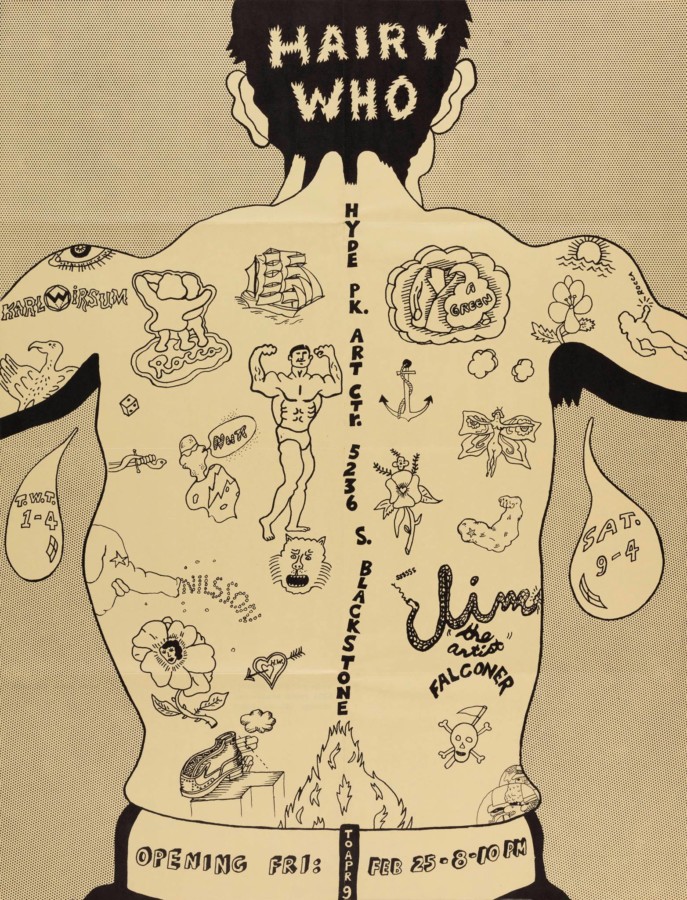Lecture: Hairy Who? 1966-1969
@ The Art Institute of Chicago, Fullerton Hall
111 S Michigan Ave, Chicago, IL 60603
Opening Thursday, November 1st, from 12PM - 1PM
On view through Sunday, January 6th
Exhibition co-organizer and researcher Thea Liberty Nichols guides you through the artwork and archival finds of the exhibition Hairy Who? 1966–1969, highlighting the Chicago histories and cultural significance of the group of six Chicago artists known as the Hairy Who.
Fullerton Hall
Free with museum admission, registration required
REGISTER—http://bit.ly/2OCb8nZ
About the exhibition:
As the Hairy Who, Jim Falconer, Art Green, Gladys Nilsson, Jim Nutt, Suellen Rocca, and Karl Wirsum—all recent graduates of the School of the Art Institute of Chicago—began mounting unconventional displays of bright, bold graphic work at the Hyde Park Art Center on the city’s South Side. Over a period of four years, they transformed the art landscape of Chicago, injecting their new and unique voices into the city’s rising national and international profile. The Art Institute is proud to organize this first-ever major survey exhibition dedicated solely to the groundbreaking exhibition group.
Like all Americans of their generation, the young Chicagoans of the Hairy Who came of age during a period of national upheaval that witnessed the escalation of the war in Vietnam, assassinations of political figures, student protests, a rising counterculture, tumultuous racial and gender relations, and the expansion of a capitalist consumer economy.
Their work—vividly unbridled yet also formally refined—embodied irreverence and youthful fearlessness. Between 1966 and 1969, they staged six uninhibited and informal exhibitions—three in Chicago and one each in San Francisco, New York, and Washington, DC.
To request an accessibility accommodation for an Art Institute program, please call (312) 443-3680 or send an email to access@artic.edu as far in advance as possible.
Image: Jim Falconer, Art Green, Gladys Nilsson, Jim Nutt, Suellen Rocca, and Karl Wirsum. Hairy Who, 1966. The Art Institute of Chicago, gift of Gladys Nilsson and Jim Nutt.
—
About the show:
Neither a movement nor a style, Hairy Who was simply the name six Chicago artists chose when they decided to join forces and exhibit together in the mid-1960s.
As the Hairy Who, Jim Falconer, Art Green, Gladys Nilsson, Jim Nutt, Suellen Rocca, and Karl Wirsum—all recent graduates of the School of the Art Institute of Chicago—began mounting unconventional displays of bright, bold graphic work at the Hyde Park Art Center on the city’s South Side. Over a period of four years, they transformed the art landscape of Chicago, injecting their new and unique voices into the city’s rising national and international profile. The Art Institute is proud to organize this first-ever major survey exhibition dedicated solely to the groundbreaking exhibition group.
Like all Americans of their generation, the young Chicagoans of the Hairy Who came of age during a period of national upheaval that witnessed the escalation of the war in Vietnam, assassinations of political figures, student protests, a rising counterculture, tumultuous racial and gender relations, and the expansion of a capitalist consumer economy.
Their work—vividly unbridled yet also formally refined—embodied irreverence and youthful fearlessness. Between 1966 and 1969, they staged six uninhibited and informal exhibitions—three in Chicago and one each in San Francisco, New York, and Washington, DC.
Although the Hairy Who chose to exhibit together, they were six individuals with their own personal, chiefly figurative vocabularies. They each radically manipulated source material collected from everyday life—including advertisements, comics, posters, and sales catalogs—with technical virtuosity. Their sense of humor embraced idiosyncrasy and spontaneity with wordplay, puns, and inside jokes that often belied the transgressiveness of their subject matter. Ambiguous, provocative, but also strategic, their work transmitted progressive ideas that challenged prevailing notions of gender and sexuality, social mores and standards of beauty, and nostalgia and obsolescence.
This comprehensive exhibition and accompanying publication—presented on the 50th anniversary of the group’s final Chicago show—features approximately 225 works assembled from public and private collections, together with key works drawn from the Art Institute’s collection, and includes large-scale paintings, sculpture, and works on paper as well as archival ephemera that contextualize the artists’ creative processes and working methods.
Official Website
More events on this date
Tags: Chicago, Fullerton Hall, Gallery 271, Hairy Who? 1966-1969, Illinois, Lecture: Hairy Who? 1966-1969, Loop, The Art Institute of Chicago, Thea Liberty Nichols

« previous event
next event »